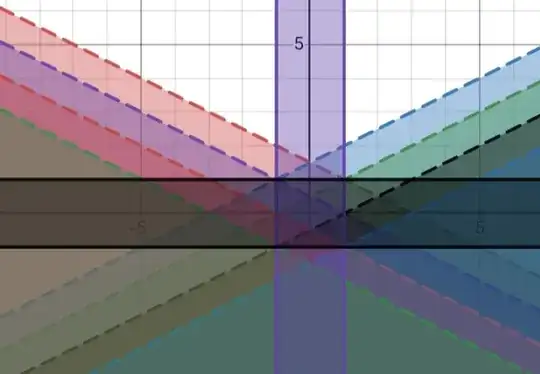In a comment, you said
I have added graph and from graph we have seen that one square with vertices $(±\frac 12,0)$ and $(0,±\frac 12)$.
I think this is not correct since $(x,y)=(0,0)$ (which is inside the square) does not satisfy $\sin^2(\pi x)+\sin^2(\pi y)>1$.
After getting
$$\sin^2(\pi x)+\sin^2(\pi y)>1\iff \cos(2\pi y)<\cos(\pi-2\pi x)$$
one can do as follows :
$$\begin{align}&\cos(\pi-2\pi x)-\cos(2\pi y)\gt 0
\\\\&\iff -2\sin\bigg(\frac{\pi-2\pi x+2\pi y}{2}\bigg)\sin\bigg(\frac{\pi-2\pi x-2\pi y}{2}\bigg)\gt 0
\\\\&\iff \sin\bigg(\frac{\pi-2\pi x+2\pi y}{2}\bigg)\sin\bigg(\frac{\pi-2\pi x-2\pi y}{2}\bigg)\lt 0
\\\\&\iff \sin\bigg(\frac{\pi-2\pi x-2\pi y}{2}\bigg)\lt 0\lt\sin\bigg(\frac{\pi-2\pi x+2\pi y}{2}\bigg)
\\&\qquad\qquad \text{or}\ \sin\bigg(\frac{\pi-2\pi x+2\pi y}{2}\bigg)\lt 0\lt\sin\bigg(\frac{\pi-2\pi x-2\pi y}{2}\bigg)\end{align}$$
$$\small\iff \bigg(2k_1\pi\lt \frac{\pi-2\pi x+2\pi y}{2}\lt (2k_1+1)\pi\ \text{and}\ (2k_2+1)\pi\lt \frac{\pi-2\pi x-2\pi y}{2}\lt (2k_2+2)\pi\bigg)$$
$$\small\text{or}\ \bigg((2k_3+1)\pi\lt \frac{\pi-2\pi x+2\pi y}{2}\lt (2k_3+2)\pi\ \text{and}\ 2k_4\pi\lt \frac{\pi-2\pi x-2\pi y}{2}\lt (2k_4+1)\pi\bigg)$$
$$\small\iff \bigg(x+2k_1-\frac 12\lt y\lt x+2k_1+\frac 12\ \text{and}\ -x-2k_2-\frac 32\lt y\lt -x-2k_2-\frac 12\bigg)$$
$$\small\text{or}\ \bigg(x+2k_3+\frac 12\lt y\lt x+2k_3+\frac 32\ \text{and}\ -x-2k_4-\frac 12\lt y\lt -x-2k_4+\frac 12\bigg)$$
where $k_1,k_2,k_3,k_4\in\mathbb Z$.

With $x,y\in[-1,1]$, we see that the region is four squares.
a square whose vertices are $(1/2,0),(1,1/2),(1/2,1),(0,1/2)$
a square whose vertices are $(0,1/2),(-1/2,1),(-1,1/2),(-1/2,0)$
a square whose vertices are $(-1/2,0),(-1,-1/2),(-1/2,-1),(0,-1/2)$
a square whose vertices are $(0,-1/2),(1/2,0),(1,-1/2),(1/2,-1)$
Therefore, the area of the region is $4\times (\frac{\sqrt 2}{2})^2=\color{red}2$.

